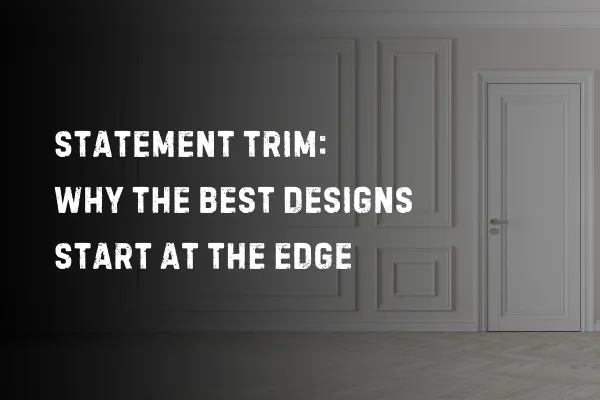
Statement Trim: Why the Best Designs Start at the Edge
Most people think design begins with the big stuff. Floors. Walls. Countertops. That thousand-dollar light fixture that promises to make your kitchen look like it belongs in Architectural Digest. Here’s the truth: none of it lands without the frame.
Trim is the edge of the canvas. It’s the punctuation at the end of a sentence. It’s the detail that signals whether a room is thoughtful or slapped together. The problem? Too many homes settle for trim as an afterthought. Thin, generic, painted-over strips of wood that barely register. Functional, sure. Memorable? Not even close.
Let’s be clear. Trim is not just decoration. It’s architecture’s quiet flex. The right trim defines the line between wall and ceiling, between floor and baseboard, between ordinary and intentional.
Why the Edge Matters
Edges are how we judge quality. You don’t assess a suit by its fabric alone. You look at the stitching. You don’t grade a steak just by the cut. You notice the sear. Trim is that for your home. When it’s thick, clean, and designed with purpose, it elevates the entire space. When it’s cheap and flimsy, it drags everything down with it.
Baseboards: The Foundation of First Impressions
The baseboard is often the first trim element you notice when walking into a room. Chunky baseboards add gravity, making the room feel grounded. Skimpy ones? They whisper “builder grade.”
Door and Window Casings: Frames That Actually Frame
A window without a proper casing looks naked. Door casings that are too thin feel like a missed opportunity. Surrounding openings with bold trim creates visual anchors and symmetry, especially in open spaces.
Crown Molding: The King of Detail
Yes, crown molding had a reputation for being fussy, but today’s designs prove otherwise. Clean, sharp crown can modernize a room while adding height and elegance. Skip it and the room might feel unfinished, like it’s missing its collar.
Statement Trim Styles
Think beyond paint-grade pine. Wide flat stock for a modern vibe. Deeply profiled casings for traditional homes. Even black or natural wood trims are making comebacks as bold accents. Trim is the place where you can break out of white-on-white and introduce character.
The Domino Effect
Here’s what happens when trim gets an upgrade. Suddenly, your walls look sharper. Your paint job feels richer. Your flooring reads as higher-end. Why? Because every edge is crisp, defined, and deliberate. It’s the detail most people can’t quite name but instantly feel.
The Bottom Line
The best designs don’t start in the middle of the room. They start at the edges. Trim is where a home signals intention. It’s the difference between “good enough” and “built to last.” When the edges are bold, clean, and deliberate, the rest of the design doesn’t just look better—it feels better. If you want a home that reads as high-end, start by giving attention to the details most people overlook.